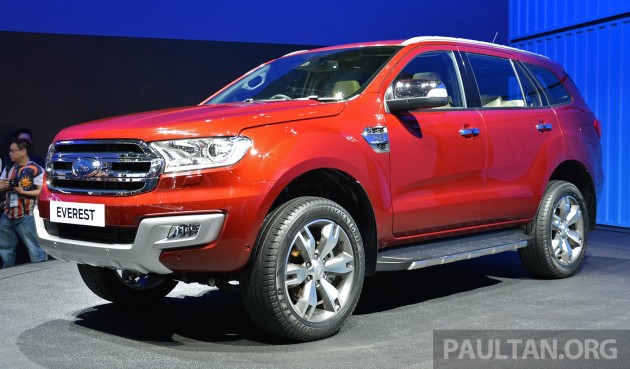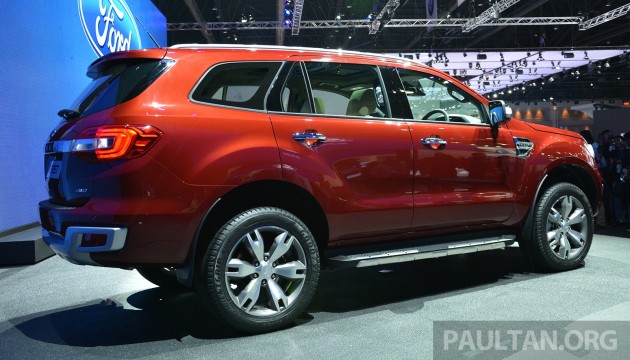
Sime Darby Auto Connexion has begun teasing the third-generation 2015 Ford Everest, which made its ASEAN debut at the 36th Bangkok International Motor Show earlier in the week, but the SUV won't be making its way to Malaysia until sometime in the third-quarter of this year.
When it does arrive, the available versions of the Australian-developed T6-based crossover will likely follow the model convention and specifications set by the Thai market models, of which there are three - a rear-wheel drive 2.2L Titanium 4x2 AT and all-wheel drive 3.2L Titanium 4x4AT and 3.2L Titanium+ 4x4AT.
Australia is also set to deploy only the diesel versions of the type, which means that the 2.0 litre EcoBoost petrol engine (the new unit that debuted on the Edge, not the existing mill seen on the Focus ST or the Mondeo) that has been mentioned for the Everest will not be seen in Asia-Pacific markets.

As already intimated in the launch posts of the facelifted Ranger and Everest in Bangkok, no change to the output of the first two Puma mills seen on the vehicles - the P5AT 3.2 litre five-cylinder Duratorq continues on with 197 hp and 470 Nm of torque, but features a reworked EGR system for better efficiency.
The ZSD-422 2.2 litre four-cylinder Duratorq TDCi engine, however, has had its output bumped up to 158 hp and 385 Nm from the 148 hp and 375 Nm seen on the pre-facelift Ranger (also, the 'new' high-efficiency derivative of the ZSD-422 on the Ranger now offers 129 hp, up by six over the 123 hp seen on the current Ranger XL)
In terms of transmissions, the ASEAN region Everest variants will only be available with the 6R80 six-speed automatic, which has been recalibrated for use in the SUV, but Australia will also feature the six-speed Getrag MT82 manual as an option. The auto-only route isn't surprising, given that the SUV is more of a lifestyle-based proposition than its Ranger pick-up sibling, in these parts at least.
General kit for the Thai-spec Everest includes leather seats, cruise control, dual-zone air-conditioning, a rear AC with control switch, auto headlamps, roof rails, six airbags (the Titanium+ adds the driver-knee airbag to make it seven), a SYNC 2 system with eight-inch colour touchscreen and 10-speaker audio system.
Projector headlamps also make their way on to the 2.2L and 3.2L Titanium variants, but it's the 3.2L Titanium+ that gets all the flash and dash. The list includes HID headlamps and LED DRLs, heated side mirrors, puddle lamps, LED scuff plates, changeable seven-colour ambient lighting and front parking sensors.
The Titanium+ also gets a power-adjustable front passenger seat (as standard, only driver-side for the other two variants), a rear view camera and a powered rear liftgate. That lovely panoramic moonroof seen on the Thai show vehicle is only available on the +, as is BLIS, Cross Traffic Alert and Active Park Assist.

Also, the six-spoked 20-inch alloys (and 265/50 Goodyear EfficientGrip rubbers) seen in Bangkok will only be worn by the Titanium+ - the 2.2L and 3.2L Titanium will feature a different 18-inch wheel, wrapped with 265/60 profile tyres.
We're a long way away from any indicative pricing for the Everest here, but the Thai models should give an approximation of what to expect - pricing in the Kingdom starts from 1,269,000 baht (RM142,938) for the base 2.2L Titanium 4×2AT, while the 3.2L Titanium 4×4AT goes for 1,459,000 baht (RM164,339), and the top-of-the-line 3.2L Titanium+ 4×4AT is 1,599,000 baht (RM180,108).



No comments:
Post a Comment